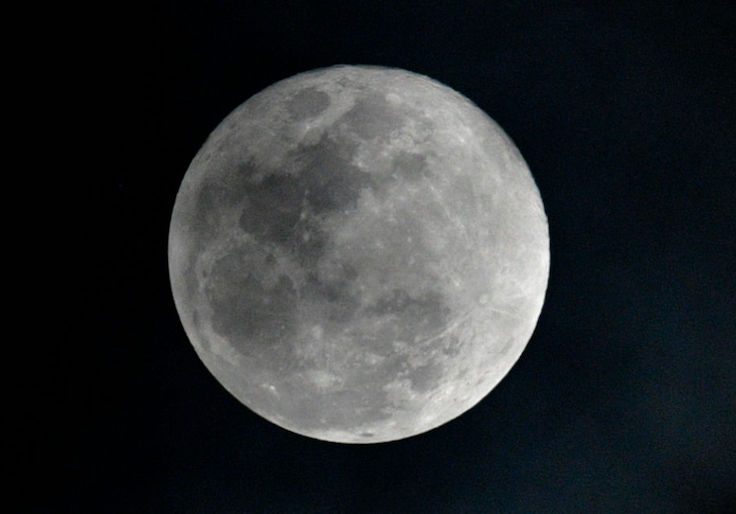Mankind has long been captivated by the moon. From ancient civilizations worshipping it as a deity; to its appearance in one of the first blockbuster movies, A Trip to the Moon; to Dean Martin waxing—if you'll pardon the pun—lyrical about it (and pizza pies) while singing about love, the moon has been ever-present in every corner of our culture. It has been a symbol of rebirth, purity, insanity. But in the 20th century this cosmic body came to mean one thing: the ultimate prize in the Space Race.
It's this relatively brief moment that the latest exhibit at the Metropolitan Museum of Art commemorates. The exhibit, titled Apollo's Muse: The Moon in the Age of Photography, celebrates the 50th anniversary of the Apollo 11 mission and tracks humanity's fascination with the moon in a photographic history from the early days of photography right up to Neil Armstrong's one small step and beyond.
Apollo's Muse starts not with pictures, but artistic depictions of the moon from the pre-photography days. Sketches of what Galileo Galilei saw of the moon through his homemade telescope in 1610 are on display, as are engravings by Claude Mellan, a French artist who created one of the first moon maps in 1635. Some early depictions of the moon, while dazzling, are unsurprisingly scientifically inaccurate. For example, one artist named John Russell possessed the means to draw a relatively true to life depiction of the moon, but believed that it was the job of the artist to correct and perfect "flaws" in natural scenes. The result of his efforts, from 1805, was a gorgeously rendered moon that, while recognizable, would drive an astronomer mad with its inexactitudes.
Of course, with the advent of photography coming a few short decades later, Russell's approach was not long for the world; the new medium didn't allow artists the chance to alter nature's design. The exhibit features the first surviving photo of the moon, a daguerreotype taken in 1840 by John Willis Draper, a med-school professor and photography enthusiast. The picture is small and of poor quality, but a monumental feat for the day. Camera technology was still in its infancy, so low-grade that Draper had to manually move the lens to keep the moon in focus during the painstakingly long 20 minute exposure process. It was such a complex and difficult procedure that it took Draper months to finally capture a clear image of the moon.
Celestial photography quickly became of interest to scientists once they realized the medium's possibilities. And with rapidly improving cameras they were soon able to produce better photographs. A series of photos from the 1850s taken by John Adams Whipper and James Wallace Black are displayed at the Met. While they're still not as detailed as those produced by modern scientific instruments, they do stack up just fine compared to modern photography enthusiasts. And by the 1860s British astronomer Warren de la Rue was able to create 3-D images of the moon using two pictures combined in a stereoscopic viewer.
The exhibit contains more than just scientific photographs: The role of the moon in art is explored as well. There are gorgeous depictions of what artists imagined the moon would be like in illustrations from Jules Verne's From Earth to the Moon, paintings from Romantic era artists, and even photos from a 1901 fairground ride that was made up of a 30-seat spaceship that simulated a trip to the moon. After disembarking from the craft, fair workers dressed as aliens offered green cheese to visitors, of which there were four hundred thousand, including Thomas Edison and President McKinley.
As engrossing as all of these pieces are, they are just the opening act, the lead up to the room devoted to space travel. Immediately recognizable is The Blue Marble, a photograph of Earth taken by an astronaut on Apollo 17 and the most reproduced photo in history. There's a stunning photo from the Apollo 8 mission of Earth cresting the moon’s horizon, Neil Armstrong walking on the moon, Buzz Aldrin's footprint, the NASA control center during the Apollo 11 mission. An era-accurate television even shows the CBS broadcast of the moon landing on a loop. If you can walk through this room without feeling a swell of patriotism you need to a heart transplant. Sure the Soviets made important contributions, many of which, like the first image of the dark side of the moon, are documented in the exhibit. But there is only one flag flying on the moon, and it isn't theirs.
While the moon is nominally the focus of Apollo's Muse, walking through the exhibit one realizes it is really a celebration of human ingenuity and the can-do spirit. Galileo creating a telescope powerful enough to view the moon in order to draw it; Draper photographing the moon; the NASA scientists finding a way to the moon—the pieces represent instances of man facing an obstacle and finding a way around it. It is, in other words, a fitting tribute for the 50th anniversary of the Apollo 11 mission and the mission's driving ethos as exclaimed by JFK:
"We choose to go to the Moon! We choose to go to the Moon in this decade and do the other things, not because they are easy, but because they are hard; because that goal will serve to organize and measure the best of our energies and skills, because that challenge is one that we are willing to accept, one we are unwilling to postpone, and one we intend to win, and the others, too."
